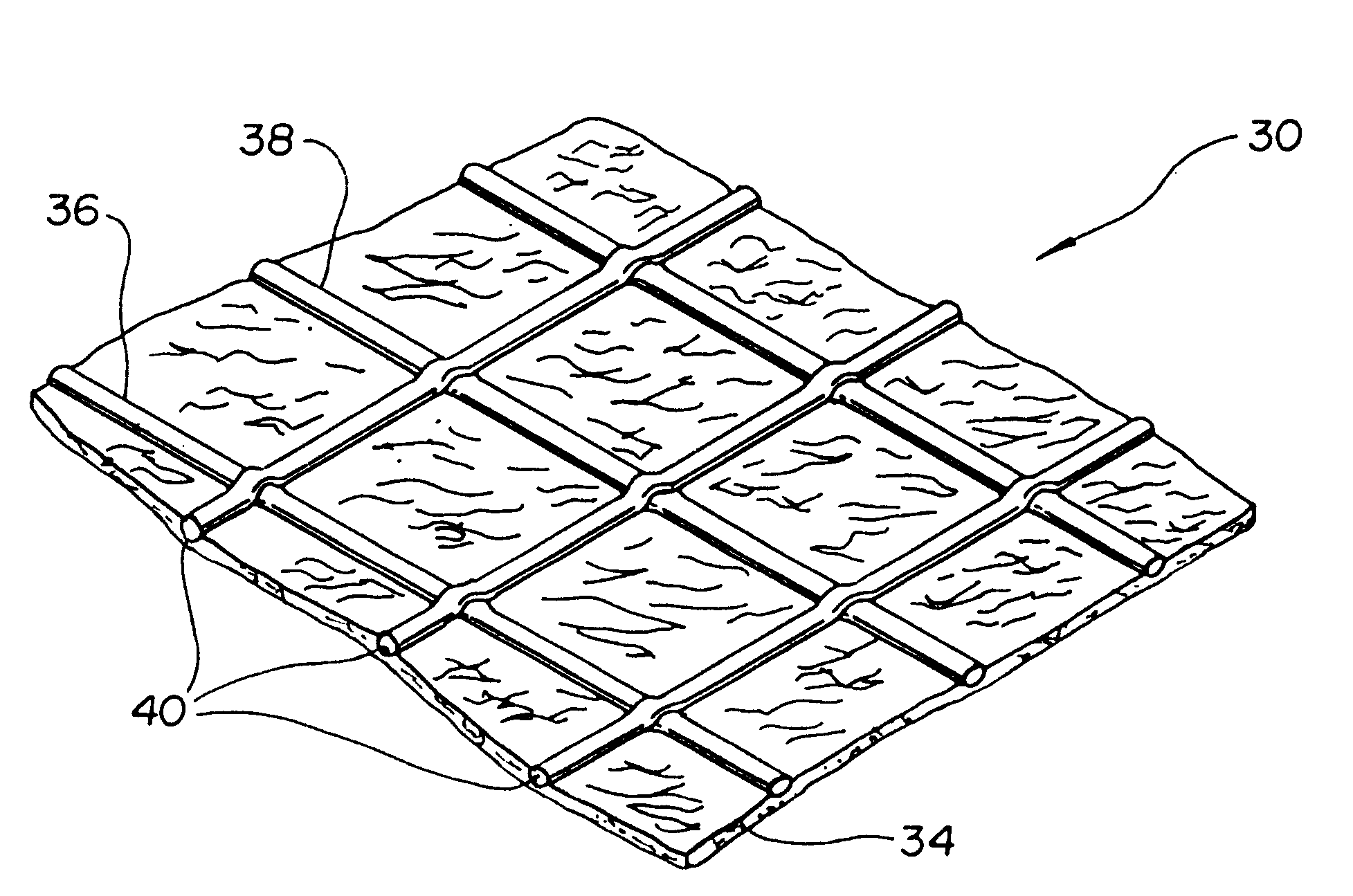Extruded netting exhibiting stretch and bonding
- Summary
- Abstract
- Description
- Claims
- Application Information
AI Technical Summary
Benefits of technology
Problems solved by technology
Method used
Image
Examples
example 1
An extruded netting with an MD strand count of 12 per inch, and a TD strand count of 7 per inch weighing 22 PMSF (pounds per 1,000 square feet) is used. The netting's MD strands are made from EXACT* 4041 resin (a mVLDPE resin made by Exxon Chemical), which has a melt temperature of 152.degree. F. The netting TD strands are made from a blend containing 85% VECTOR* 7400D(a styrene-butadiene-styrene block copolymer resin with a styrene:butadiene ratio of 31:69, and containing 33% oil from Dexco Polymers) and 15% STYRON* 678C(a general purpose polystyrene resin from Dow Plastics). The elastomer blend is affected by its polystyrene glass transition temperature of 200.degree. F. The netting is laminated to a 1.0 oz / yd.sup.2 spunbonded polyolefin nonwoven fabric. The components are laminated at 180.degree. F., with a nip pressure of 180 pli at a line speed of 11 fpm following 13 seconds of hot roll preheat time. The netting is positioned with the elastic TD strands next to the nonwoven. Th...
example 2
An extruded netting with an MD strandcount of 12 per inch, and a TD strandcount of 7 per inch weighing 22 PMSF (pounds per 1,000 square feet) is used. The netting's MD strands are made from EXACT* 4041 resin (an mVLDPE resin made by Exxon Chemical), which has a melt temperature of 152.degree. F. The netting TD strands are made from a blend containing 85% VECTOR* 7400D(a styrene-butadiene-styrene block copolymer resin with a styrene:butadiene ratio of 31:69, and containing 33% oil from Dexco Polymers) and 15% STYRON* 678C(a general purpose polystyrene resin from Dow Plastics). The elastomer blend is affected by its polystyrene glass transition temperature of 200.degree. F. The netting is laminated to a 1.0 oz / yd.sup.2 spunbonded polyolefin nonwoven fabric. The components are laminated at 180.degree. F., with a nip pressure of 180 pli at a line speed of 11 fpm following 13 seconds of hot roll preheat time. The netting is positioned with the MD strands next to the nonwoven. The resulti...
example 3
An extruded netting with an MD strandcount of 12 per inch, and a TD strandcount of 7 per inch weighing 22 PMSF (pounds per 1,000 square feet) is used. The netting's MD strands are made from ESCORENE* LD 720.62 resin (an EVA resin from Exxon Chemical containing 19.3% VA), which has a melt temperature of 185.degree. F. The netting TD strands are made from a blend containing 85% VECTOR* 7400D (a styrene-butadiene-styrene block copolymer resin with a styrene:butadiene ratio of 31:69, and containing 33% oil from Dexco Polymers) and 15% STYRON* 678C (a general purpose polystyrene resin from Dow Plastics). The elastomer blend is affected by its polystyrene glass transition temperature of 200.degree. F. The netting is laminated to a 1.0 oz / yd.sup.2 spunbonded polyolefin nonwoven. The components are laminated at 210.degree. F., with a nip pressure of 180 pli at a line speed of 11 fpm following 13 seconds of hot roll preheat time. The netting is positioned with the elastic TD strands next to ...
PUM
| Property | Measurement | Unit |
|---|---|---|
| Fraction | aaaaa | aaaaa |
| Fraction | aaaaa | aaaaa |
| Fraction | aaaaa | aaaaa |
Abstract
Description
Claims
Application Information
 Login to View More
Login to View More - R&D
- Intellectual Property
- Life Sciences
- Materials
- Tech Scout
- Unparalleled Data Quality
- Higher Quality Content
- 60% Fewer Hallucinations
Browse by: Latest US Patents, China's latest patents, Technical Efficacy Thesaurus, Application Domain, Technology Topic, Popular Technical Reports.
© 2025 PatSnap. All rights reserved.Legal|Privacy policy|Modern Slavery Act Transparency Statement|Sitemap|About US| Contact US: help@patsnap.com



